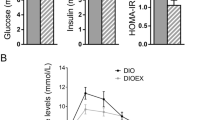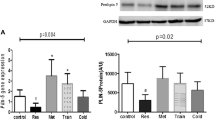Abstract
With aging, there is a reduction in mitochondrial activity, and several changes occur in the body composition, including increased adiposity. The dysfunction of mitochondrial activity causes changes and adaptations in tissue catabolic characteristics. Among them, we can mention brown adipose tissue (BAT). BAT’s main function is lipid oxidation for heat production, hence playing a role in adaptive thermogenesis induced by environmental factors such as exercise. It is known that exercise causes a series of metabolic changes, including loss body fat; however, there is still no consensus in the academic community about whether both strength and aerobic exercise equally reduces adiposity. Therefore, this study aimed to evaluate the effects of strength training and aerobic exercise regimes on adiposity, proteins regulating mitochondrial activity, and respiratory complexes in BAT of old rats. The rats were divided in two control groups: young control (YC; N = 5), and old control (OC; N = 5), and two exercise groups: strength training (OST; N = 5), and aerobic treadmill training (OAT; N = 5). Rats were subjected to an 8-week exercise regime, and their body composition parameters were evaluated (total body weight, adiposity index, and BAT weight). In addition, mitochondrial biogenesis proteins (PGC-1α, SIRT1, and pAMPK) and respiratory chain activity (complexes I, II/III, III, and IV) were evaluated. Results showed that OST and OAT exercise protocols significantly increased the mitochondrial regulatory molecules and respiratory chain activity, while body fat percentage and adiposity index significantly decreased. Taken together, both OST and OAT exercise increased BAT weight, activity of respiratory complexes, and regulatory proteins in BAT and equally reduced body adiposity.



Similar content being viewed by others
Abbreviations
- AMPK:
-
Adenosine monophosphate-activated protein kinase
- BAT:
-
Brown adipose tissue
- DTT:
-
Dithiothreitol
- EDTA:
-
Ethylenediaminetetraacetic acid
- NADH:
-
Nicotinamide adenine dinucleotide dehydrogenase
- NRF-1:
-
Nuclear respiratory factor 1
- NRF-2:
-
Nuclear respiratory factor 2
- OAT:
-
Aerobic treadmill training
- OC:
-
Old control
- OST:
-
Strength training
- PGC-1α:
-
Peroxisome proliferator-activated receptor gamma coactivator 1-alpha
- PMSF:
-
Phenylmethylsulfonyl fluoride
- ROS:
-
Reactive oxygen species
- SDS-PAGE:
-
Sodium dodecyl sulfate polyacrylamide gel electrophoresis
- SIRT1:
-
Sirtuin 1
- SNS:
-
Sympathetic nervous system
- VEGF:
-
Vascular endothelial growth factor
- YC:
-
Young control
References
Bernlohr DA (2014) Exercise and mitochondrial function in adipose biology: all roads lead to NO. Diabetes 63(8):2606–2608
Bostrom P, Wu J, Jedrychowski MP, Korde A, Ye L, Lo JC, Rasbach KA, Boström EA, Choi JH, Long JZ et al (2012) A PGC1-α-dependent myokine that drives brown-fat-like development of white fat and thermogenesis. Nature 481:463–468
Boudina S, Graham TE (2014) Mitochondrial function/dysfunction in white adipose tissue. Exp Physiol 99(9):1168–1178
Bratic A, Larsson NG (2013) The role of mitochondria in ageing. J Clin Invest 123(3):951–957
Cannon B, Nedergaard J (2004) Brown adipose tissue: function and physiological significance. Physiol Rev 84(1):277–359
Canto and Auwerx (2009) PGC-1alpha, SIRT1 and AMPK, an energy sensing network that controls energy expenditure. Currr Opin Lipidol 20(2):98–105
Cassina A, Radi R (1996) Differential inhibitory action of nitric oxide and peroxynitrite on mitochondrial electron transport. Arch Biochem Biophys 328(2):309–316
Cloos PA, Christgau S (2004) Post-translational modification of proteins: implications for aging antigen recognition, and autoimmunity. Biogerontology 5(3):139–158
Cocco T, Sgobbo P, Clemente M, Lopriore B, Grattagliano I, Di Paola M, Villani G (2005) Tissue specific changes of mitochondrial functions in aged rats: effect of a long-term dietary treatment with N-acetylcysteine. Free Radic Biol Med 38:796–805
Davies SM, Poljak A, Duncan MW, Smythe GA, Murphy MP (2001) Measurements of protein carbonyls, ortho and meta-tyrosine and oxidative phosphorylation complex activity in mitochondria from young and old rats. Free Radic Biol Med 31:181–190
Fischer JC, Ruitenbeek W, Stadhouders AM, Trijbels JMF, Sengers RCA, Janssen AJM, Veerkamp JH (1985) Investigation of mitochondrial metabolism small human skeletal muscle biopsy specimens. Clin Chim Acta 145:89–100
Fulco M, Sartorelli V (2008) Comparing and contrasting the roles of AMPK and SIRT1 in metabolic tissues. Cell Cycle 7(23):3669–3679
Gerhart-Hines Z, Rodgers JT, Bare O, Lerin C, Kim SH, Mostoslavsky R, Alt FW, Wu Z, Puigserver P (2007) Metabolic control of muscle mitochondrial function and fatty acid oxidation through SIRT1/PGC-1 alpha. EMBO J 26(7):1913–1923
Habinowski SA, Witters LA (2001) The effects of AICAR on adipocyte differentiation of 3T3-L1 cells. Biochem Biophys Res Commun 286(5):852–856
Hornberger TA Jr, Farrar RP (2004) Physiological hypertrophy of the FHL muscle following 8 weeks of progressive resistance exercise in the rat. Can J Appl Physiol 29(1):16–31
Igbal S, Ostojic O, Singh K, Joseph AM, Hood DA (2013) Expression of mitochondrial fission and fusion regulatory proteins in skeletal muscle during chronic use and disuse. Muscle Nerve 48:963–970
Kim HS, Kim DG (2013) Effect of long-term resistance exercise on body composition, blood lipid factors, and vascular compliance in the hypertensive elderly men. J Exerc Rehabil 9(2):271–277
Kohrt WM, Malley MT, Dalsky GP, Holloszy JO (1992) Body composition of healthy sedentary and trained, young and older men and women. Med Sci Sports Exerc 24(7):832–837
Konopka AR, Miranda Suer K, Christopher Wolff A, Matthew Harber P (2014) Markers of human skeletal muscle mitochondrial biogenesis and quality control: effect of age and aerobic exercise training. J Gerontol A Biol Sci Med Sci 69(4):371–378
Lagouge M, Argmann C, Gerhart-Hines Z, Meziane H, Lerin C, Daussin F, Messadeq N, Milne J, Lambert P, Elliott P, Geny B, Laakso M, Puigserver P, Auwerx J (2006) Resveratrol improves mitochondrial function and protects against metabolic disease by activating SIRT1 and PGC-1 alpha. Cell 127(6):1109–1122
Lo KA, Sun L (2013) Turning WAT into BAT: a review on regulators controlling the browning of white adipocytes. Bio Sci Rep 33(5):e00065
Lowry O, Rosebrough NJ, Farr AL, Randall RJ (1951) Protein measurement with the Folin phenol reagent. J Biol Chem 193(1):265–275
Mennes E, Dungan CM, Frendo-Cumbo S, Williamson DL, Wright DC (2014) Aging-associated reductions in lipolytic and mitochondrial proteins in mouse adipose tissue are not rescued by metformin treatment. J Gerontol A Biol Sci Med Sci 69:1060–1068
Niederberger E, King TS, Russe OQ, Geisslinger G (2015) Activation of AMPK and its impact on exercise capacity. Sports Med 45(11):1497–1509
Peng XR, Gennemark P, O’Mahony G, Bartesaghi S (2015) Unlock the thermogenic potential of adipose tissue: pharmacological modulation and implication for treatment of diabetes and obesity. Front Endocrinol 6:174
Picard F, Guarente L (2005) Molecular links between aging and adipose tissue. Int J Obes 29:S36–S39
Picard F, Kurtev M, Chung N, Topark-Ngarm A, Senawong T, Machado De Oliveira R, Leid M, McBurney MW, Guarente L (2004) Sirt1 promotes fat mobilization in white adipocytes by repressing PPAR-gamma. Nature 429(6993):771–776
Puigserver P, Rhee J, Lin J, Wu Z, Yoon JC, Zhang CY, Krauss S, Mootha VK, Lowell BB, Spiegelman BM (2001) Cytokine stimulation of energy expenditure through p38 MAP kinase activation of PPAR gamma coactivator-1. Mol Cell 8:971–982
Rustin P, Chretien D, Gerard B, Bourgeron T, Rotig A, Saudubray JM, Munnich A (1994) Biochemical and molecular investigations in respiratory chain deficiencies. Clin Chim Acta 228:35–51
Sanchez-Delgado G, Martinez-Tellez B, Olza J, Aguilera CM, Gil A, Ruiz JR (2015) Role of exercise in the activation of brown adipose tissue. Ann Nutr Metab 67(1):21–32
Scheffer DL, Silva LA, Tromm CB, da Rosa GL, Silveiira PC, de Souza CT, Latini A, Pinho RA (2012) Impact of different resistance training protocols on muscular oxidative stress parameters. Appl Physiol Nutr Metab 37(6):1239–1246
Stanford KI, Middelbeek RJ, Goodyear LJ (2015) Exercise effects on white adipose tissue: beiging and metabolic adaptations. Diabetes 64(7):2361–2368
Suwa M, Nakano H, Kumagai S (2003) Effects of chronic AICAR treatment on fiber composition, enzyme activity, UCP3, and PGC-1 in rat muscles. J Appl Physiol 95:960–968
Thirupathi A, de Souza CT (2017) Multi-regulatory network of ROS: the interconnection of ROS, PGC-1 alpha, and AMPK-SIRT1 during exercise. J Physiol Biochem 73:487–494
Thirupathi A, Pinho R (2018) Effects of reactive oxygen species and interplay of antioxidants during physical exercise in skeletal muscles. J Physiol Biochem 74:359–367
Vilela TC, Muller AP, Damiani AP, Macan TP, da Silva S, Canteiro PB, de Sena Casagrande A, Pedroso GDS, Nesi RT, de Andrade VM, de Pinho RA (2017) Strength and aerobic exercises improve spatial memory in aging rats through stimulating distinct neuroplasticity mechanisms. Mol Neurobiol 54:7928–7937
Vilela TC, Effting PS, Dos Santos Pedroso G, Farias H, Paganini L, Rebelo Sorato H, Nesi RT, de Andrade VM, de Pinho RA (2018) Aerobic and strength training induce changes in oxidative stress parameters and elicit modifications of various cellular components in skeletal muscle of aged rats. Exp Gerontol 106:21–27
White Z, Terrill J, White RB, McMahon C, Sheard P, Grounds MD, Shavlakadze T (2016) Voluntary resistance wheel exercise from mid-life prevents sarcopenia and increases markers of mitochondrial function and autophagy in muscles of old male and female C57BL/6J mice. Skelet Muscle 6(1):45
Woods JA, Wilund KR, Martin SA, Kistler BM (2012) Exercise, inflammation and aging. Aging Dis 3(1):130–140
Wright DC, Han DH, Garcia-Roves PM, Geiger PC, Jones TE, Holloszy JO (2007) Exercise induced mitochondrial biogenesis begins before the increase in muscle PGC-1 alpha expression. J Biol Chem 282(1):194–199
Acknowledgements
This work was supported by the Universidade do Extremo Sul Catarinense, Criciuma, SC, Brazil. The Authors thanks professor Fernando Antonio Basile Colugnati of the Health Graduate Program of Juiz de Fora Federal University for statistical support.
Author information
Authors and Affiliations
Corresponding author
Ethics declarations
The study protocol was reviewed and approved by the local ethics committee according to the Guidelines for Animal Care and Experimentation (number 16/2013).
Conflict of interest
The authors declare that they have no conflicts of interest.
Additional information
Publisher’s note
Springer Nature remains neutral with regard to jurisdictional claims in published maps and institutional affiliations.
Rights and permissions
About this article
Cite this article
Thirupathi, A., da Silva Pieri, B.L., Queiroz, J.A.M.P. et al. Strength training and aerobic exercise alter mitochondrial parameters in brown adipose tissue and equally reduce body adiposity in aged rats. J Physiol Biochem 75, 101–108 (2019). https://doi.org/10.1007/s13105-019-00663-x
Received:
Accepted:
Published:
Issue Date:
DOI: https://doi.org/10.1007/s13105-019-00663-x




